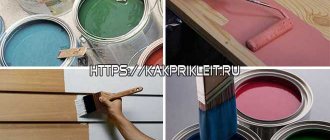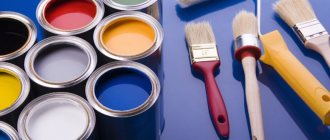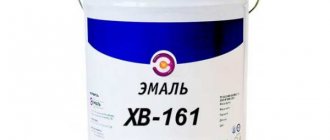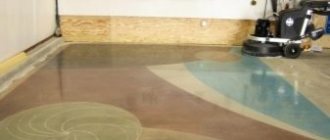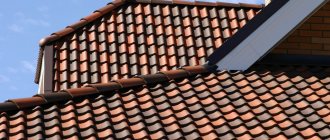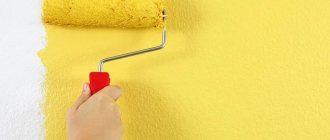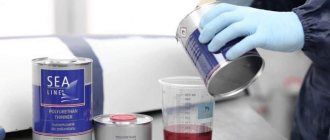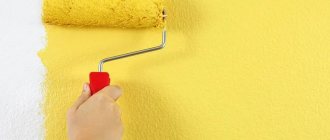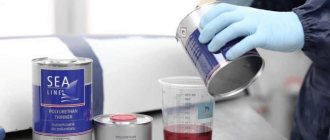Paint is one of the most popular finishing materials. Enamel is the most popular of its “competitors”. Its popularity is due to its ease of use and pleasant appearance after completion of the work - it produces a beautiful glossy surface, in addition, the cost of this material is quite low. In order for a surface finished in this way to last as long as possible, it is necessary to choose the right paint.
Differences between materials and their compatibility
Terminology and composition
This is what real ceramic enamel looks like.
Enamel paints are a narrow segment of paint and varnish coatings that are highly durable and consist of a dispersion of pigments, fillers and various additives in a film-forming substance, the role of which is most often played by varnish, alkyd resin or other substance with similar physical and chemical properties.
Enamel paint is often applied to batteries.
Oil paints consist of natural, synthetic or combined drying oil, in which all the same pigments, fillers and auxiliary target additives are dispersed. Modern types of oil paints are most often mixed with glyphthalic, pentaphthalic and combined drying oils, as well as oxol drying oil.
Oil-phthalic coating is often called enamel.
Moreover, many manufacturers strive to create the appearance of a rich assortment and assign certain names to their products, based on the qualities that need to be emphasized. So, in order to highlight the strength or special shine of its product, the manufacturer calls it enamel, although this product has nothing to do with enamel as such. Of course, the price increases along with the growth of pathos in the product name.
Example of a polymer product.
The first enamel paints arose after pentaphthalic drying oil began to be modified with alkyd resins, as a result of which a more durable and durable coating appeared on the market. In order to somehow distinguish it from others and focus on increased quality, the material was called enamel, so that everyone would understand that the product is stronger and better than simple paintwork materials.
We can say this: material based on pentaphthalic drying oil is called enamel, and material based on boiled linseed oil (natural drying oil) is called paint. If you look at the labeling of cans, you will notice that often all enamel cans have the index PF (pentaphthalic), and all simple ones have the index MA (oil). There are also primers with the designation GF, which indicates glyphthalic drying oil in the composition.
Drying oil based materials.
Types of enamel paints
To talk about the compatibility of materials, you need to understand what enamel materials exist. Let’s say right away that there are so many of them that it will be problematic to cover them all without exception.
We will name the main ones:
- Nitrocellulose (NC). Consist of cellulose nitrate, pigments, additives and solvents. They are mainly applied to metal, concrete and wooden surfaces. Available in cans and aerosol cans, they are distinguished by the characteristic pungent odor of acetone and are incompatible with other formulations without special preparation;
- Organosilicon (SO). They are applied to almost any coating and material and are characterized by heat resistance, moisture resistance and high wear resistance. Compatible only with cured acrylic coatings;
- Pentaphthalic and glypthalic (PF, GF). They are a type of oil paint based on synthetic and combined drying oils modified with alkyd resins. Compatible with epoxy, alkyd-urethane and acrylic compounds;
- Acrylic (AK). These are water-dispersible polymer latex mixtures that are compatible only with water-soluble materials, but can be applied to old coatings of almost any composition with appropriate processing and preparation;
- Urethane (UR) and alkyd-urethane (AU). High-strength, wear-resistant coatings that can be applied to oil and pentaphthalic bases, and they are also compatible with epoxy compounds.
Table of compatibility of various paints and varnishes with bases and old coatings.
The list can be continued for a long time, but for this it is easier to look at the special material compatibility tables that can be found on our website. An attentive reader could already have found the answer to the question: “Is it possible to paint with oil paint on nitro enamel?” - in no case, since nitrocellulose materials simply curl up in other solvents, and when applied they form bubbles and swell. (See also the article Spray gun for painting: features.)
Don’t be surprised if you see that some sellers classify fire-retardant paints for metal Polistil as enamel, because even Zinga electrically conductive paint is sometimes included in this category.
Marking PF 115: meaning decoding
When purchasing paint, enamels or varnishes, you need to know the composition and characteristics. The numbers and letters on the bank have a specific meaning.
The name of the solution is always indicated first - paint, varnish or enamel.
Then mark the second group of signs. The letters PF indicate that the enamel is made from a solution of modified pentaphthalic resin (pentaphthalic varnish).
Number 1 - enamel is intended to cover external surfaces at any temperature, and 15 is a unique number of the material, which is indicated by the manufacturer (GOST).
Paints and varnishes can be made on the basis of natural polymerization resins or cellulose ether and are distinguished by a wide range and color.
As for alkyd enamel PF-115, the paint was produced more than 50 years ago (the brand is regulated by GOST 6465-76).
Over so many years, it has consolidated its reputation, is inexpensive and is considered one of the most popular on the markets, despite the wide range of new paint materials.
Many manufacturers try to save money and change the composition of paints at their own discretion, which negatively affects the quality of the product and reduces its service life.
To avoid running into an “experimentalist,” buy enamel only with the PF-115 “GOST” mark on the can.
Cans with a modified composition are marked “TU”.
As for the types of enamel, there are industrial and retail. Industrial ones need to be diluted with additional solutions (they are available in concentrated form). Liquid (retail) is ready for home use, but in some cases it is also diluted.
Preparation of enamel paints
The preparation of enamels consists of the following operations:
- mixing dry pigment with a binder in mixers,
- grinding the resulting mixture on a paint grinder,
- diluting the resulting paste with varnish or solvent to the required consistency
- package.
When choosing a binder for rubbing paints, it should be borne in mind that the use of rapidly volatile solvents is undesirable. Therefore, the grinding is often carried out using drying oil or linseed oil, diluting it later with varnish. The most common type of mixers are the Werner and Pfley-derer systems, as well as trunk ones.
The binder is poured into the mixer, the pigment is added and stirred until a uniform mixture is obtained. The stirred mixture is sent to the paint grinders for fumes. Three types of paint grinders are used: roller, cone or disk and ball mills. Solvent loss occurs on open roller paint grinders. Depending on the variety, it is passed through rolling 2-4 times.
Cone or burr grinders and ball mills are used for very liquid solvents containing highly volatile solvents. They are not very productive. After rubbing, the paint is diluted with varnish and solvents to the desired consistency.
Recently, single-roller paint grinders have begun to be used to remove debris and large particles. Laval centrifuges are also used for cleaning. After cleaning from debris, it goes to bottling. It is recommended to soak the finished enamel paint before bottling, after which it gives better shine and bottling. Iron containers are not recommended; galvanized or aluminized ones are preferable. It must be airtight; contact with air must be excluded.
Exterior paints
They must be resistant to atmospheric influences. Of the old varieties of copal varnishes, greasy copal varnishes were used for this purpose, mainly on cowrie or congo copals. Currently, varnishes based on polymerized or oxidized linseed oil or a combination of wood oil and linseed oil are more often used. Resins used include harpius ethers and artificial resins such as albertol.
In the manufacture of these resins, various combinations are possible, so their production is of greatest practical importance for the paint and varnish industry. Resins containing phenol are not lightfast; They are not suitable for white enamels. Glyptals modified with phenol and oils are water-resistant, elastic, have good solubility and compatibility with other binders and pigments. By combining these resins with conventional oil-based varnishes, a binder is obtained that combines the fast-drying properties and good adhesion with the gloss and water resistance of old resin varnishes.
Varnishes made from oil glyptals and alkydals can successfully replace not only ordinary oil varnishes, but also nitro varnishes, since the drying time of an oil-glyptal varnish at 100° is close to the drying time of nitro varnishes at normal temperatures. The enamels on these varnishes provide weather-resistant coatings.
Pentaphthalic
Pentaphthalic enamels are ready-to-use paints used for exterior use when painting surfaces exposed to weather conditions (except roofs).
Perchlorovinyl
Perchlorovinyl enamels cure quickly (1-3 hours) and provide waterproof and weatherproof coatings. Due to the rapid hardening, perchlorovinyl enamels are applied mainly with paint sprayers. They are used for painting the facades of critical buildings and structures. They are applied to metals only on a specially primed surface. Perchlorovinyl enamels are diluted with special solvents consisting of acetone, butyl acetate and toluene. Due to the long-lasting unpleasant odor of solvents, they cannot be used for interior painting of residential premises. Perchlorovinyl varnishes and enamels are used as acid- and alkali-resistant coatings (over special primers) when exposed to weak solutions of acids and alkalis.
Bitumen-oil and bitumen-glyphthalic
Bitumen-oil and bitumen-glyphthalic enamels - for example, aluminum enamel on bitumen-oil varnish. To obtain these enamels, aluminum powder is mixed with varnish immediately before use. The paint produces a light silver finish that is water resistant and more weather resistant than the original varnish binders. Recently, these paints have been used for painting (in two layers) steel and cast iron structures (frames, balcony grilles, etc.) and even steel roofs. However, the durability of bitumen binders for painting roofs is still low.
What is enamel paint
This material is one of the types of paint and varnish coatings. The enamel paint contains the following 5 components:
- Varnish;
- Solvent or white spirit;
- Fillers;
- Various functional additives;
- Pigments of a certain color, which should be the shade of enamel paint.
Enamels can be used to perform various works, both external and internal, as they fit well on any surface. Enamel paints are suitable for any materials: wood, metal, concrete and even brick. However, it should be remembered that it is better not to use it in fire hazardous conditions, since the varnish contained in the composition is flammable.
Enamels have good performance properties; they protect the rough surface well from high humidity, as well as from aggressive environmental influences. At the same time, before staining, there is practically no need to prepare, but more on that later.
Types of enamels
There are different types of enamel paints, so here is a list of them:
- Alkyd enamel is considered the most popular. Alkyd enamel paint has a number of advantages - they are durable, easy to apply, have an elastic structure and dry quickly. They are very often used in rooms with high air humidity, for example, in bathrooms or swimming pools, as they tolerate temperature changes and moisture. Alkyd paint, like any other, has its own designation so that it can be easily found, for example, with a penta-flannel base, it is designated as PF-253. The numbers also have their meaning, the first number is the purpose, therefore, 1 is for external work, 2 is for internal work. The last 2 digits are the catalog number;
- Nitroenamel - the basis of this type of enamel paint - is cellulose nitrate. Their peculiarity is that they dry almost instantly under normal conditions, at room temperature. However, environmental pollution from enamel paints of this type is very high. Therefore, their use in many countries is significantly limited or completely prohibited. Most often they are used for painting wood surfaces. The application of such a coating is carried out mainly using special sprayers; this is done in this way, since quickly drying paint is very difficult to apply using the usual physical method;
- Polyurethane enamels - the main advantage is wear resistance. In this regard, they are used for painting floors in general purpose rooms, that is, with high traffic, for example in school corridors or in museums. On the second day after completion of work, the painted surface is completely ready for use. Remember about safety precautions, enamel paints are toxic, so you need to work with them in special protective equipment - gloves and safety glasses. The room must be ventilated during and after completion of work.
Features of application
Due to their versatility, alkyd enamels can be used on almost any surface. For interior decoration, this material is actively used for painting radiators. However, it is necessary to make sure that the product can withstand high temperatures so that the coating does not begin to crack during the heating season.
This type of paint coating can also be used for painting wood products. It should be taken into account that the enamel on such a coating dries for at least 30 hours. Also, the material is too viscous, so it is best to dilute it with a solvent.
Thus, alkyd enamel is an excellent finishing material, which is famous for its durability, reliability and affordable price.
From the following video you will learn about the advantages of alkyd enamels over other types of paints.
Oil paint MA-15
This oil paint is suitable for outdoor use, as indicated by the number “1”. The number “5” means that a mixture of combined drying oils is used for its production. It is intended for painting wooden and metal surfaces.
Oil paint MA-15
Knowledge of markings for enamels and other paint and varnish products is undoubtedly useful. It can immediately orient the buyer and save him from making the wrong choice. Moreover, the marking itself is not at all complicated and you don’t need to spend a lot of time to understand it.
Benefits and Features
For some reason, many people think that enamel paint and enamel are the same thing, but this is completely wrong. Enamel is a glass-type coating that contains quartz particles, metal alkali, pigments and other components. When an enamel coating is applied to a surface, it is heat-cured to make the item durable and resistant to wear. This material is often used to cover ceramics, dishes and bathroom surfaces.
Enamel paints are a watery or gel-like product that contains an organic type solution that creates a film on the surface. This process occurs due to the presence of alkyd resin in the varnish composition. Certain manufacturers use other components, but with similar chemical properties.
After the paint dries, a dense film appears on the base, which performs a protective function and increases resistance to surface wear. It protects against abrasion, small scratches, water and dirt due to its repellent properties. This point is extremely important for most women who hate or do not want to spend a lot of time on the cleaning process. The enamel-coated surface simply needs to be wiped with a damp cloth, and it returns to its original appearance.
Another great advantage of enamel paints and varnishes is their beautiful shine, which will give the base a beautiful, rich appearance. This property depends not just on the film former, but on specialized additives. Most professional painters prefer to paint surfaces with enamel compounds - they are easy to work with, they are easy to apply and lay down in an ideal layer. They should be applied to primer, wood and metal.
Enamel paints and varnishes can be applied in one layer, and modern manufacturers offer a wide range of such materials that have a different color palette. All customers can choose their colors depending on the required shade and preferences. The affordable cost of goods gives enamel paints and varnishes a higher value than their oil counterparts.
In addition to many advantages, such paints have nuances that are important to consider when purchasing. A huge disadvantage will be a sharp and toxic aroma, which is not found in simple paints.
It is necessary to work with such varieties carefully, and you also need to wear a respiratory mask to protect the body from toxic poisoning. Jars must be stored in a special way; they should only be kept upright and away from small children.
Recommendations for performing work
The technology for painting ceilings with enamel involves preparing the surface at the first stage. The decorative coating is removed from the base, which is true for paint, plaster or wallpaper. Significant irregularities are filled with putty, as are interpanel seams. To decorate cracks, it is better to use cement paste. Excess solution is removed with a spatula. If leveling will be carried out with plaster, then you first need to apply a primer, then a leveling layer, and after it dries, another layer of primer for painting.
Before applying paint to the plaster, you need to make sure that the surface is absolutely flat, and remove small irregularities with sandpaper.
For work, you can use water-based paint, which can be white or tinted in any shade. First, the composition is diluted in a small amount and tested on a piece of plywood to understand what color the enamel is. Then you can apply it to the entire surface of the ceiling. You can use different tools for this, for example, a roller or spray. In the latter case, the process will go faster, but the technology is used only if there are no pieces of furniture in the room.
Attention! Before you paint the ceiling, you will need to select an enamel roller. The latter may have an aggressive composition, for which artificial pile materials are suitable. When purchasing a mixture based on acrylic or latex, you will have to use a roller, the working part of which consists of polyamide or polyester.
The choice of enamel for the facade and features of its use
The facade should be painted with enamel, which will withstand changes in temperature, humidity and mechanical stress. Among the most common paints for external walls are:
- silicate;
- cement;
- rubber;
- lime;
- acrylic;
- silicone.
If the facade is made of brick, it is better to cover the walls with acrylic paint, which forms a breathable layer. The enamel is mixed well before application, and a primer is applied to the walls. Painting is carried out in two layers. Between which time is maintained for complete drying.
It is better to use a spray bottle to distribute the material over the surface, but in windy weather this technology can cause increased consumption of enamel. If you choose a roller, you should also purchase a brush to effectively paint hard-to-reach areas.
Powder paint technology
Powder enamel is increasingly used today for painting wood, metal pipes, sports equipment and other things. This uses electrostatic spray technology. The base is pre-prepared to achieve better application quality.
In the process of applying the powder, a special gun is used, which is removed 30 cm from the surface. Before applying paint, the surface is well prepared, be it wooden or metal bases. The durability of the coating, its elasticity and strength depend on this stage.
Painting wood or any other material also involves applying a primer to the surface. The technology is waste-free, environmentally friendly, but requires the use of special equipment. Painting may involve the use of a powder spray booth. The coating can be heat-resistant if special-purpose powder compositions were used in the work. If painting is carried out with a polymer powder mixture, the surface becomes hygroscopic, which means that operation is possible only indoors.
Paint composition and properties
The basis of any alkyd paint is a special varnish and a solvent that allows you to obtain the desired consistency. A variety of fillers that provide certain properties and additives (for example, a protective antiseptic) are also used. Pigments give paint the desired color.
The alkyd-based varnish used in the production of paint can be glyphthalic or pentaphthalic. For the manufacture of paints, pentaphthalic varnish is mainly used, which consists of alkyd resins mixed with vegetable oils, glycerin and rosin. Solvent is added to thin the paint.
The properties of the material depend on the specific type of product. After application and complete drying, it may have:
- increased degree of density of the protective layer;
- excellent water-repellent properties;
- resistance to mechanical damage;
- resistance to aggressive detergents and cleaning agents.
A wide range, affordable price and ease of use are another plus in the treasury of advantages of paints of this type.
It is worth remembering that the toxicity of paint at the stage of its use is quite high; many will not like the strong smell of the material. However, after the treated surface dries, the environmental issue is removed and the harmful effects are reduced to zero.
The presence of solvents in alkyd paints makes them a fire hazard, so operation requires strict adherence to safety measures.
Features of application on different types of surfaces
Let's take a closer look at how to properly apply paint to various types of surfaces.
Metal
Painting begins after the primer has completely dried. To prepare a metal surface, use compositions VL-05, GF-021 and other types of metal primers compatible with pentaphthalic varnish. Structures with traces of corrosion are additionally treated with rust converters immediately before priming.
Special products will slow down the oxidative processes in existing foci, convert loose oxides into solids and prevent the appearance of new foci of rust.
Tree
The technical characteristics of PF-115 enamel allow it to be applied without priming, but in 2-3 layers. It is recommended to pre-impregnate the wood with fire retardants, antiseptics, fungicides, and other protective agents that are not part of the enamel.
Mineral bases
Plaster, concrete, brick can be painted without priming. It is necessary to thoroughly dry the surface before starting work. Enamel forms a dense vapor-proof film, so residual moisture in the pores of the base can cause cracking at low temperatures, provoke mold growth, etc.
Fresh concrete walls, foundations, and other structures can be painted no earlier than six months after completion of construction.
Enamel paints application and subtleties
The first thing worth mentioning when talking about working with this finishing material is whether it is necessary to putty the surface for enamel paint. On this issue we can say that not at all, enamel has good adhesion to all known materials, so preparation with putty is not necessary. If there are no significant irregularities on the surface, it is enough to simply clean it thoroughly from dust and dirt, and then prime it, and if this paint is intended for ceramics and enamel coatings, then you can do without priming. When it comes to the question of how to dilute enamel paint, we can say with confidence that thinners of any type, as well as a solvent, are suitable here.
The most popular manufacturers, review
The most effective enamel paints are products from well-known manufacturers. Among the best companies are the Japanese manufacturer Tamiya, the Irish brand HUMBROL, the English brand Dulux, the German company Caparol, the Danish company Sadolin and the German-Polish joint venture Hansa.
The advantage of these brands is explained simply; they have many years of experience in the production of paints and varnishes. All of the listed manufacturers have products of the highest quality and an excellent reputation.
Russian manufacturers are also actively working to create the highest quality products. The following companies can please customers with their results:
- Belgorod enterprise "Painting paints";
- Yaroslavl production "SpetsEmal";
- St. Petersburg.
The most effective enamel paints are products from well-known manufacturers.
All paints and varnishes have individual technical characteristics. Therefore, in order to choose the most optimal option, you need to familiarize yourself with all the subtleties and nuances of enamels.
Based on organic solvents
Paints and varnishes based on organic solvents (for example, white spirit or solvent) are intended for external and internal work. When applied and dried, fumes are released that negatively affect human health. Work must be carried out in rooms with forced ventilation; the painter should use protective gloves and a respirator. Enamels are applied manually or with a spray gun (coatings with increased absorbent characteristics are pre-primed).
Alkyd dyes
Enamels are based on alkyd varnish (glyphthalic or pentaphthalic), diluted with turpentine or white spirit. The composition includes pigments that determine the shade, fillers (for example, oils to increase the elasticity of the coating, or sand or granite chips to form a rough layer). Enamels for wooden structures contain antiseptic additives to protect the base from fungi and rot.
Alkyd paints, after drying, form very durable, waterproof and chemically inert surfaces of varying degrees of gloss.
Enamels
The materials are intended for painting metal, wood, plastic, and concrete structures. To change the shade, various types of pigments are used that are dissolved in the varnish. After polymerization, a smooth, shiny coating is formed; it takes from 15 to 45 minutes to harden. Enamels are suitable for exterior and interior use; they may contain components that neutralize rust. The layer can withstand prolonged exposure to ultraviolet radiation and is neutral to precipitation and temperature changes.
Oil paints
Paints consist of organic or synthetic drying oil or oil in which pigments and additives are dissolved. To increase fluidity, organic solvents are used (for example, turpentine, purified gasoline or solvent). The materials have a low cost and final price, but it takes several days to harden. Artistic oil-based enamels dry after 12-14 months. When exposed to sunlight and air, the coating acquires a yellowish tint.
Composition of paints and varnishes
These products are used for priming the surface and direct painting (giving a certain color). They also provide protective functions for the base from many external, negative factors: metal from corrosion, ultraviolet radiation, temperature changes, high humidity, etc.
NOTE! Despite the general scope and some external similarities, these two materials have completely different compositions, application methods and performance characteristics. However, there is such a thing as enamel paint. It also differs in its parameters from classic enamel and conventional paintwork.
Enamel
The composition may include alkaline oxides of various metals, which give the product a certain color. For example, cobalt oxide produces blue-black, cadmium produces red, and copper produces green. The basis of the mixture is powdered quartz sand. The composition of modern high-tech products may include silicon dioxide, titanium, zinc, lead or aluminum oxide, alkaline earth metal fluorides, etc.
The resulting powder mixture is mixed with water and applied to the working base. After preliminary drying, the object on which it is applied is subjected to heat treatment at a temperature of 750°C-950°C. It is baked into a monolithic glassy mass.
The undoubted advantage of this method of application is high adhesion (adhesion) to the surface of the base, as well as the possibility of thermal exposure. An example of everyday use is ordinary enamel pots, teapots, ceramic products, and enamel-coated bathtubs.
Traditional enamel is applied to: metal (low carbon steel), copper, silver (in jewelry), ceramics, glass. However, the application technology imposes certain technical restrictions on the temperature resistance of the base material.
Dye
The basis of classic paints and varnishes (paint and varnish mixtures) are film-forming substances. They can be of both natural and synthetic origin. Natural oils include various vegetable oils such as drying oil, which is subjected to heat treatment during the production process. As well as various resins (rosin), bitumen or protein substances (casein).
ON A NOTE! The difference between enamel and paint can be seen even by special markings: on containers with enamel compositions the abbreviation “PF” (pentaphthalic) is always indicated, but classic products have the indicator “MA” (oil). The difference from the first is a smoother and more durable layer.
Photos of types of aerosol paint
How to choose?
When purchasing an enamel paint product, you should pay attention to some details that are important and will help you make your choice.
- You should carefully examine the jar from all sides. There should be no dents or other damage on it. If the seal is broken, the internal composition may lose its characteristics.
- You also need to look at the expiration date, since old paint will not give the desired effect.
- You should look for the inscription “GOST” on the jar: this will guarantee the high quality of the product.
It is recommended to pay attention to the code of the paint and varnish material; it is indicated in large letters and numbers on the front side of the package. One of the best domestic manufacturers is, producing coatings of any type
A wide palette is represented by paints of any color (white, red, black, green, yellow, dark blue tones are especially in demand)
One of the best domestic manufacturers is, producing coatings of any type. A wide palette is represented by paints of any color (white, red, black, green, yellow, and dark blue tones are especially in demand).
Production
The following companies are called the best manufacturers of enamel paints:
- Tamiya (Japan).
- HUMBROL (It was founded in 1919 in the UK. But it was recently bought by an owner from Ireland).
- Beckers (Sweden).
- Dulux (UK).
- Caparol (Germany).
- Hansa (Germany, Poland).
- Sadolin (Denmark).
These brands have a long history. As a rule, production at the very beginning had nothing to do with dyes. They expanded later when demand arose. All companies have proven themselves, producing products of the highest quality.
Some started out producing single-color paints, like the Japanese company Tamiya. And the very next year there were twelve flowers. Brands could be created in one country and then purchased in another, so production became joint, as happened with the Hansa company.
Domestic manufacturers are working intensively on the quality of their products, and the results please consumers:
- Paint and Varnish Materials Plant “Paints for Painting” (Belgorod region, Rzhevka village. There are many branches. One of them is located in Moscow).
- Factory “SpetsEmal” (products are of high quality. Located in Yaroslavl).
- Company “Pigment” (Russia, St. Petersburg).
Many other factories, companies, and factories produce enamel paints of a wide variety of colors and compositions.
Features and Benefits
Many people believe that enamel and enamel paint are the same thing, but this is completely false. Enamel is a glassy coating that contains quartz particles, metal alkali, colored pigment and other components. When a surface is covered with enamel, it is treated in a special thermal way, which ensures the strength and wear resistance of the item. Enamel is often used to cover dishes, ceramics, and bathroom surfaces.
Enamel paint was created by chemists who were able to saturate pentaphthalic drying oil with special alkyd resins. In contrast, ordinary paints are made from an oil-based natural drying oil. Manufacturers mark this point on the label with information about the composition. The presence of pentaphthal is marked with the letters PF, oily materials have the abbreviation MA. The first has a uniform, dense and shiny coating; for many, these factors are decisive when choosing.
Enamel paints and varnishes are a gel-like or watery product containing an organic solution that forms a film. This process occurs due to the presence of varnish or alkyd resin in the composition. Some manufacturers use other components, but with similar chemical properties.
After the paint dries, a dense film is formed on the base, which performs a protective function and increases the wear resistance of the surface. It protects against abrasion, shallow scratches, dirt and water, thanks to its repellent properties.
Another great advantage of enamel paints is their incredible shine, which gives the base a rich and beautiful appearance. This property depends not so much on the film former as on special additives.
Most professional painters prefer to paint surfaces with enamel products: they are easy to work with, they apply well and lay down in an even layer. They can be applied to wood, soil and metal.
Enamel paints can be painted in one coat. Modern manufacturers offer a wide range of these materials, with a varied palette of colors. Any buyer will be able to choose a color depending on the desired shade and personal taste. The affordable price of goods gives enamel paints and varnishes a greater advantage over their oil counterparts.
In addition to so many advantages, enamel paints have nuances that need to be taken into account when purchasing. The big disadvantage is the toxic and pungent odor, which is absent in ordinary paints. You should work with enamel varieties carefully. It is necessary to wear a respiratory mask to protect the body from toxic poisoning. Cans must be stored in a special way. They should stand exclusively in an upright position (as far as possible from children).
Enamel and oil: similarities, differences
Let's see how enamel differs from oil paint. The description of both products makes it clear that their production technologies are very similar. So, the composition contains a base and pigment.
The similarities between the two materials are determined by the characteristics of their use and purpose. You can apply enamel and oil paints to all surfaces. Both options are capable of creating a protective layer. What is the difference between paint and enamel? First of all, the composition. The enamel is based on varnish. Hence the stronger smell. In the case of oil paint, the base is drying oil.
If oil paints are stored for a long time, the pigment will settle. A thick protective layer forms at the bottom of the jar. Enamel simply thickens when it needs to be stored for a long time.
Peculiarities
Acrylic paint is suitable for painting surfaces made of wood, plastic, metal and glass. It is one of the most popular finishing materials. This is due to its environmental safety and practicality. It is based on acrylic resins dissolved in a water base. Also, it has no smell.
Acrylic paint has many advantages. It is resistant to changes in temperature, so the surface coated with it will not crack. Due to its elasticity, the paint can withstand many mechanical damages. Some manufacturers create a composition that can repel water.
The paint may differ not only in composition, but also in what form and packaging it is in. Depending on what area needs to be painted and what effect you want to achieve, you can choose paint in a can or in a spray can.
Acrylic paint in a can becomes an indispensable tool when you need to quickly paint a small area of a surface or a small detail of a decorative element. This paint dries quickly enough and does not require much effort and time. It is usually used to paint a table, a bathroom, decorate a wall, or to fill in scratches on a car.
Gloss level
The reflectivity of the paint and its durability depend on the degree of gloss. The better the paint reflects light (shine), the more resistant it is to external influences. At the same time, such paint reveals all defects of the painted surface. Therefore, in each specific case, find a balance between these characteristics.
There are 5 levels of paint gloss:
- matte - practically does not reflect light, masks surface imperfections well, but does not tolerate exposure to water;
- semi-matte - weakly reflects light (has a low shine, reminiscent of the shine of an eggshell);
- satin - a compromise option between matte and glossy paints, allowing you to hide surface defects, while forming a fairly durable coating;
- semi-gloss – moderately reflects light and is highly durable;
- glossy - highly reflective, resistant to pollution, considered the most durable and durable. At the same time, gloss reveals all surface defects and is only suitable for painting perfectly smooth substrates.
